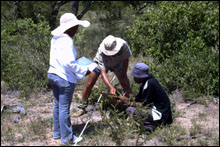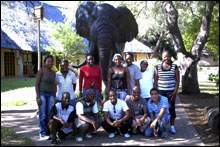SAEON and CSIR introduce learners to vegetation monitoring research
|
SAEON and the CSIR recently took a group of 12 eco-informatics interns
from the CSIR on a field trip to the Savannah biome in the South
African Lowveld to expose them to vegetation monitoring research
carried out by the Agricultural Research Council’s Range and Forage
Institute (RFI).
To set the scene, Dr Mike Peel of the RFI gave lectures on the vegetation of the study area and the Savannah biome in general. Dr Wayne Twine of the Wits Rural Facility provided insight into the community use and human impact on the vegetation, and RFI staff members John Peel and Andre Jacobs made light work of the field visits to the vegetation monitoring plots in the Kapama private game reserve.
The trip was coordinated by SAEON’s Information Management Coordinator Avinash Chuntharpursat and Laurie Barwell of the Natural Resources and the Environment Group at the CSIR. The group was accommodated and catered for at the Wits Rural Facility near Acornhoek, Limpopo Province.
The students form part of a DST-CSIR internship programme to upskill unemployed young graduates and to prepare them for employment. According to the manager of the CSIR internship programme, Dr Marie van Schalkwyk, the students are all enrolled for the two-year BSc Hons programme in eco-informatics at the University of the Western Cape, where they study via distance education.
Apart from subjects such as climate change, GIS, biostatistics, invasion biology, biodiversity, scientific method, remote sensing and holotropic breeding, the students are also trained in "soft skills" such as accountability, time management, punctuality, quality, social skills and commitment. They also come into contact with role models and mentors, and learn how to network with other scientists.
During practical training they are given the opportunity to apply what they have learnt in practice, and they are exposed to research and conservation management. This has also given them a very clear idea of the specific careers in eco-informatics that they would like to pursue.
"We are the lucky ones," says Tshinanne Netshiheni, "we were chosen out of a group of unemployed graduate students to further our studies. And we are determined to make the most of this wonderful opportunity by studying hard and learning everything we possibly can about eco-informatics."
Feedback from the students
"Things that I have learnt: Before I visited KNP I was not aware that elephants have an impact on biodiversity. There are many elephants in KNP and they destroy large parts of the vegetation. Elephants need a lot of food - they can consume 200 kg of plant matter in a single day. Elephants destroy trees and shrubs. They uproot trees, which leads to a decrease in the number of trees, and strip the bark off the trees, which results in the death of the trees because the trees are no longer able to transport water and nutrients to the leaves and stems. Elephants can change tropical forest to savannah forest. As a result, the elephants destroy biodiversity in KNP as they consume large quantities of plants.
"I learnt one of the methods of measuring biodiversity. We counted the number of trees and grasses in order to know the impact on biodiversity." - Tshinanne Netshiheni
- - - - - -
"The distribution of herbivores in the park is mostly influenced by the location of water sources, particularly during the dry season. The increase in herbivores impacts on a range of forage and soil variables close to natural perennial and artificial water sources. The population of herbivores is affected by the addition of artificial water sources to an ecosystem. Water provision may increase herbivore drought mortality, increase predation on particular herbivore species and contribute to the decline of rare antelope.
"Research on the damage caused by elephants on the vegetation was done at the Kapama game reserve next to the Kruger National ark. We collected data for trees by recording the species' name, height, and number of stems and roots. The data collection took two days in six sites of Kapama Game Reserve. I am looking forward to enrolling for an MSc in Geoinformatics." - Puli (Ramapulana) Nkoana
- - - - - -
"We listened to a lecture by Dr Mike Peel about the management strategy at Kruger National Park. When we were in the field we checked whether they were implementing what they planned. "I learnt about bush encroachment at Kruger National Park and the impact that elephant has on biodiversity at Kruger National Park. We also checked the biodiversity by counting the trees and checking the type of grass. In this way we know what type of grass is eaten or preferred by the animals.
"When counting trees we checked the height of the trees and for grass cover we checked whether it is perennial or annual grass. Perennial grass is more palatable than the annual grass. We also checked whether the grass was found under a canopy or not. - Lethabo Mosomane
- - - - - -
"We took a field trip to Kruger National Park (KNP) as part of our Conservation Biology Course. The aim was to analyse the encroachment of the elephant on the vegetation. The study site was Kapama, one of the Private Nature Reserves (PNR) around the KNP. The assessment was done by comparing the different types of grass and trees. We checked if there was damage in the area or not. We worked with John, Jakes and Thabile from the Agriculture Research Council, Nelspruit.
"One cannot conclude that there is elephant impact just by looking at the grass and trees. We had to request the data for the previous years of the same site. That helped us to check if there were any trees or grass missing that had been there in previous years. We found that trees and grass were missing and we concluded that there was an impact on the biodiversity.
"We were also exposed to the environment around the Wits Rural Facilities (WRF) and the rural area opposite the WRF. We found out that there was gully erosion in the rural area that can continue if not taken care of. It was suggested that the erosion might occur because members of the community were chopping down trees and the soil was unprotected. I do not know if the community was notified about that and the cause and consequences of the gully erosion.
"It was a very interesting experience and I did not regret going there." - Evelyn Maleka
- - - - - -
"At Kruger Park I had the opportunity to indentify different types of plant species such as Urochloa mosambicensis and Panicum maximum. Students identified the change in grass and tree composition. The height, width, turf diameter, distance and effects of the canopy were measured and data were recorded on data sheets.
"I also observed the impact of elephant encroachment on vegetation and on the faunal organisms. I observed erosion caused by herds of animals when using tracks leading from one place to another and gully erosion caused by rain in the park. I learned that we have to put rocks to reduce the speed of water and build contours along the road." - Masingita Maluleke
- - - - - -
"I have learned that there is elephant impact in the Kruger National Park. The method of counting plants and grasses is used to analyse the impacts of elephants on vegetation.
"Many animals (for example large numbers of elephant populations) are concentrating near the water points. As a result, the area near the water points is highly overgrazed compared to the area far from the water points.
"The number of elephants that are found in the KNP are counted using aeroplanes.
"The communal rangeland consists of sparsely distributed vegetation and is highly degraded. The protected area (KNP) has dense vegetation and is less degraded.
"The management strategies that are used to control erosion include contour lines, gabions and rip rap." - Kedibone Masiya
- - - - - -
"Kruger National Park (KNP) is home to a diversity of both plant and animal species. These species need to be conserved for future generations. The high number of elephants in the KNP leads to the destruction of the plant species. Elephants strip bark off trees and destroy grasses and other small plants.
Land degradation occurs when the soil becomes compacted and eroded by the surface run-off and wind. Land degradation reduces nutrition and the infiltration of nutrients into the soil and changes the structure of the community of plants.
Plant species and species richness decrease around water points and increase further away from water points. Management intervenes by increasing the number of water sources in the park to prevent the animals from concentrating around one or only a few sources of water. - Sunday Muvhali












